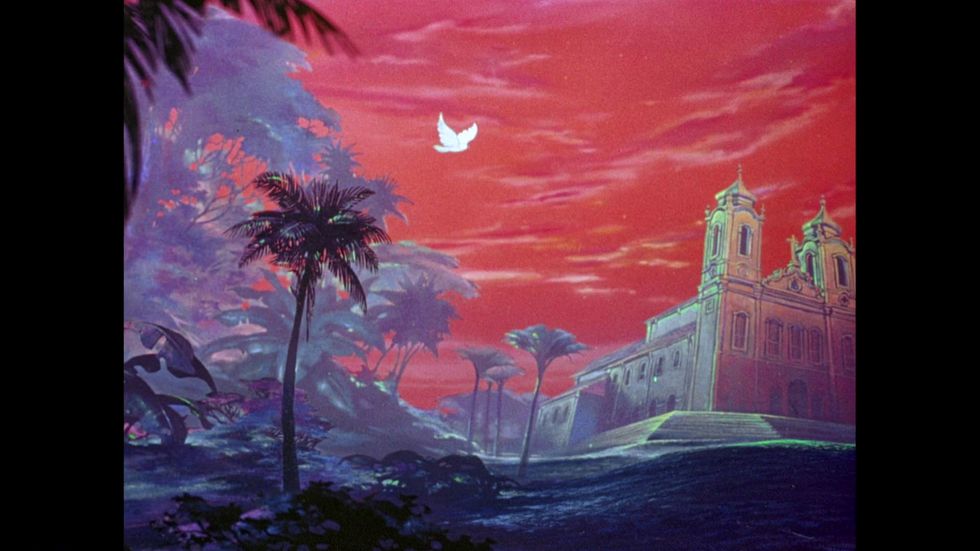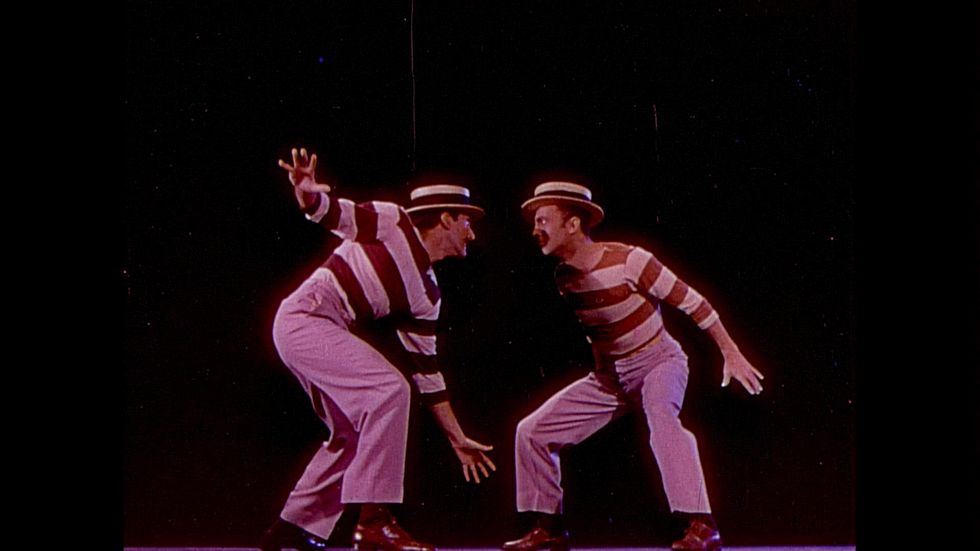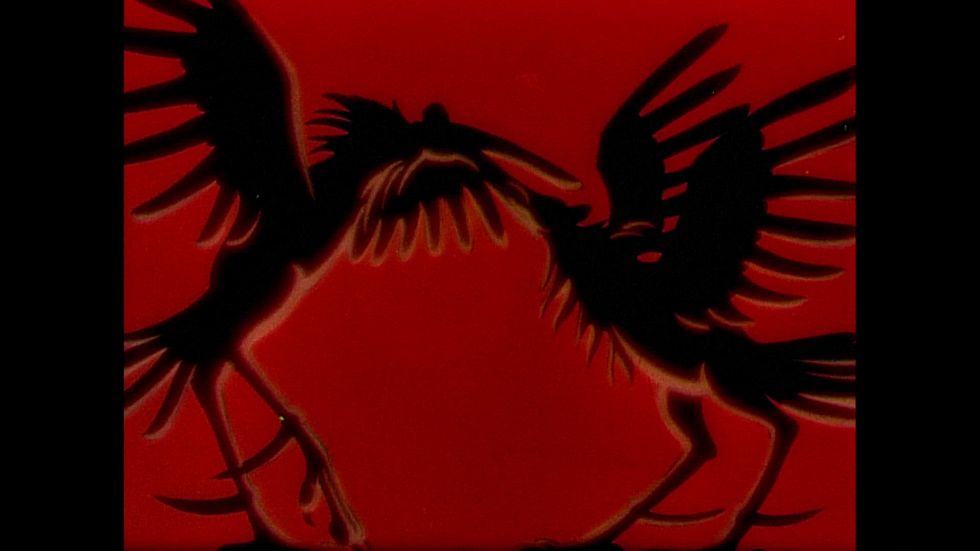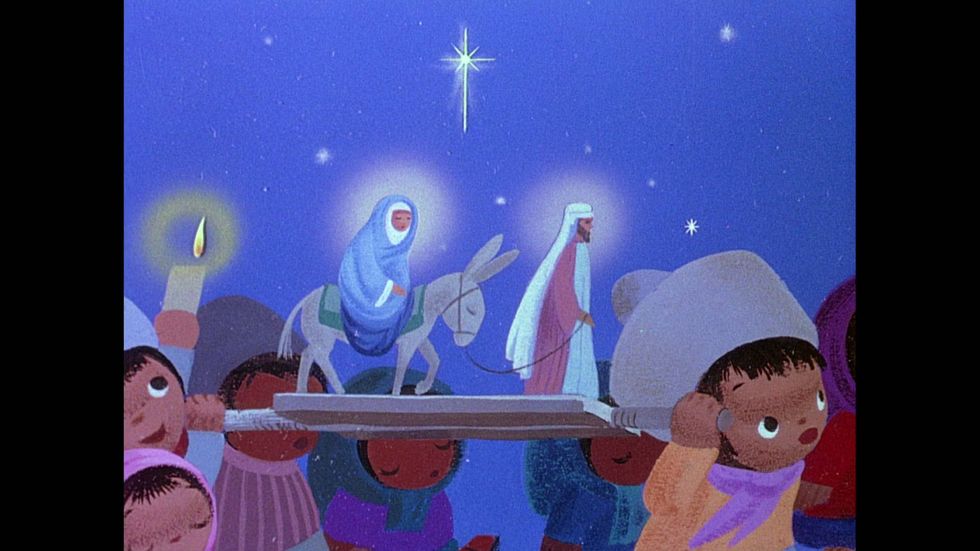Background
When looking at sequels or follow-ups, it can be hard to judge them as movies in their own right. I ran into that problem a few times while watching 1944's The Three Caballeros, but I do have to give the Disney studio credit for really trying to set it apart from Saludos Amigos, aside from using the previous film's theme as underscore in the opening scene and bringing back José Carioca. The segments are presented as gifts to Donald Duck on his birthday (Friday the 13th; how fitting) rather than being connected by documentary footage of the artists in their travels. This may be because, by this point, relations between the United States and Latin America had markedly improved, and it was no longer of utmost importance for America to win their favor.
That was probably for the best, since, although still creative and including some truly interesting aspects of Latin American cultures that I hadn't previously known, this wasn't quite as enjoyable as its predecessor.
"Aves Raras"
Donald's first gift is a film projector with a reel containing a "documentary" about Latin American birds. This brings some nice absurd humor, with the narrator conversing directly with him and some of the birds coming out of the screen and into the room with him. And, of course, what better way to start this portion of the film centering on tropical animals than with penguins?
This was a confusing subject matter to me until I found out that there are indeed colonies of penguins that live in parts of South America. But more confusing still is that the titular penguin, named Pablo, hails from the South Pole. The main conflict is that he hates the cold and wants to live somewhere warmer, which is where South America actually comes into play. The segment is narrated by Sterling Holloway (Winnie the Pooh, the Cheshire Cat, the Stork from Dumbo), whose voice was always charming, and makes good use of some imaginative visuals - some. One that stood out to me was a literal interpretation of "fog rolling in." A lot of the first portion of the film is actually fairly traditional in terms of imagery. This is much like the Pedro segment in Saludos Amigos: cute, but not some of Disney's most incredible work.
From there, we get a standard introduction to other South American birds such as the toucan and the Aracuan bird, who appears a few more times throughout the movie and, frankly, never won me over. He's just kind of annoying. Luckily, the movie as a whole really starts to pick up once this first film-within-a-film ends.
"The Flying Gauchito"
This one is similar to the El Gaucho Goofy portion of the previous film; not only because it deals with gauchos, but because of its format. Again, we have a short with a humorous narrator who sometimes speaks directly to the characters, as well as imagery that doesn't always match what the narrator says is supposed to be happening. Here, the gaucho is a young boy - the narrator when he was a child - who befriends a small flying donkey and enters a horse race with him. They win, but the donkey's wings are exposed soon after, and the two escape an angry crowd by air.
What stands out about this short is the narrator. From what I can find about him, he wasn't Latino, which makes his fake accent uncomfortable, but his dialogue is great. Since he's supposedly talking about something that happened to him as a child, there are some clever visual jokes involving him not quite remembering some details, and the imagery reflecting his confusion. I especially love his line in the end, when he says that he and the donkey were never seen again "as long as we lived." It was such an absurd line to conclude with that I couldn't help but smile.
"Bahia"
The next portion of the film brings us the return of José Carioca, one of the highlights of Saludos Amigos. He is reintroduced as a miniaturized version of himself, inside of a pop-up book given to Donald as another gift. He's awfully blasé about his situation, which serves to remind us how downright charming he is as a character. Zé Oliveira reprises the role, which makes it all the better.
What follows is a stunning montage of painted landscapes from throughout the city of Bahia, Brazil. The color palettes blend together wonderfully and there are several layered shots achieved by the multiplane camera, a device invented by Ub Iwerks in 1933, a few years after he had left the studio. It's underscored by a beautiful song about - what else - Bahia, sung by José. The song is clearly of its time, and upon looking it up I discovered that the soundtrack is almost completely comprised of popular Latin American songs of the time; even the theme song is set to a previously existing tune. That said, they did a great job selecting the music. This particular song is slow and melodic, and matches the scenery perfectly.
At the end of the song, José reappears in the art style of the montage, but is immediately snapped out of his daydream and back into the brighter colors and lighting of the transition sequences. He jumps right in to the next song, and the imagery delivers on the creativity seen from this character before. He multiplies himself, seems to magically change costumes, and, again, is able to use his umbrella as various musical instruments. When he's done frustrating Donald with the chorus ("Have you been to Bahia?" repeated over and over again - Donald has answered nearly every time), the latter joins him in the book, and they turn the page and take a pop-up train to finally go there. The visuals and character interactions throughout this sequence are much more clever and enjoyable, a clear step up from a more cookie-cutter opening.
"Os Quindins de Yayá"
Finally, the live-action/animation hybrid marketed heavily in the film's trailers appears. Aurora Miranda (sister of Carmen) portrays the "cookie lady" and dances with Donald and José, who, because they're male cartoon characters in the 1940s, are naturally smitten. The song they dance to was written in 1941, and this seems to be the most famous version of it. The two forms of media are integrated well, although there are stretches of time where Miranda doesn't so much as look at Donald or José, and when she does, it doesn't quite seem like she's really looking at anything. A lot of the time it feels like they just filmed a live-action sequence and added the two animated characters late in the game. Additionally, none of the live-action performers seem to be very invested in the number. That being said, there's still some great singing and dancing in this segment, as well as some fun usage of color and lighting toward the end of it.
Following their departure from Baía, Donald and José return to the minimalist landscape in which Donald apparently resides for another interlude filled with physics-bending action that can only be found in the animated medium. José is able to manipulate his size, light becomes a tangible object, and the images of the two characters morph into those of sound waves. Then comes the introduction of the long-awaited third Caballero, Panchito Pistoles, who bursts in literally guns blazing.
"Mexico: Las Posadas, Pátzcuaro, Veracruz, and Acapulco"
Apparently no introductions are needed within the group, since Panchito already knows the others' names and they all jump right into singing the film's theme song. After a full number that exploits cartoonish exaggeration and slapstick to nearly their fullest potential, Donald receives a piñata, and Panchito explains the significance of it in relation to the Mexican tradition of Las Posadas, wherein children travel from door to door on Christmas Eve asking for shelter and are refused at every household until they reach one that they are allowed into, representing the Virgin Mary and Joseph being turned away at the inn in Bethlehem the night Jesus was born. This sequence, for the most part, is not animated. Rather, it's a series of still images illustrating the festivities, with the only movement being the children's flickering candles. This portion piqued my interest probably more than any other sequence following it, both because I had been previously unaware of the tradition and because of the beautiful art style of Mary Blair, reportedly one of Walt's favorite concept artists.
The rest of this segment consists of another series of Blair's paintings telling the story behind the symbol in the center of the Mexican flag and more slapstick interludes between the title characters before it switches to more live-action footage with the animated characters superimposed. They travel throughout Mexico via a magic serape, or flying carpet. Although the combination of media is still well done, there aren't many creative angles in this scene to give the illusion that the characters are there and interacting with their surroundings. Much of the following content is just the three (especially Donald) gawking at attractive women on the beach in Acapulco, which the women are weirdly okay with, and even charmed by. From there we see traditional dances performed by people in Veracruz, and that's about it for anything remotely traditional or regular for the remainder of the film.
"You Belong to My Heart; Donald's Surreal Reverie"
The vignettes leading up to the finale are abstract and surreal, for sure, but unfortunately this can make the action onscreen harder to follow. First up is a performance by Mexican singer Dora Luz, in which only her head is seen against a stylized night sky, and later only her face appears inside an animated flower surrounded by neon objects against a still dark background. Unlike Aurora Miranda, Luz doesn't seem to be singing to Donald, and is totally detached from the rest of the action. After her song concludes, the majority of the film's final act is comprised of animation reminiscent of the "Pink Elephants on Parade" sequence in Dumbo. It seems this was a common choice for older Disney films, but where it was somewhat justified in Dumbo and later in The Many Adventures of Winnie the Pooh, here it just feels like a sharp left turn. The most coherent thing in it is one last performance by a live-action singer, Carmen Molina, who dances to "Jesusita en Chihuahua," a traditional song from the Mexican Revolution. Throughout this number, animated cacti accompany Molina by dancing across the screen, having been conjured and conducted by her as well.
The final sequence of the movie takes all of the slapstick, surreal imagery, and flat-out chaos it's boasted at a steady pace so far and throws it at the audience all at once. It's a display of music, cartoon violence (at Donald's expense, naturally), fireworks, and an extreme bending of the laws of physics. It takes advantage of its medium, but there didn't seem to be any clear segue from the previous sequence to this one. All of the action just flies at you and, if I'm honest, it's a bit disorienting.
Final Thoughts
As with Saludos Amigos, I have to credit this movie for not only being visually appealing with bright colors and fluid animation, but for introducing me to some aspects of Latin American culture that I doubt I would have learned about otherwise if unprompted to research them. That being said, much of the comedy is underwhelming and the live-action portions aren't integrated especially well with the animated characters and backgrounds. The performances by both the voice cast and the live-action actors are okay at worst and wonderfully charming at best, and I am overall glad that I revisited it after several years. It's a good companion piece to its predecessor, if only a slightly above average film in its own right.






















